Back to
Contents - Previous - Next
July 5 – St. Petersburg
Click a picture to see a
larger view.


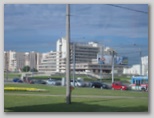 St. Petersburg depicts at
once the reason the masses revolted and the revolting mess the masses make. We
spent the day in palaces of the nobility and magnificent churches in which only
royal blood could worship. Driving between each, we passed through a city badly
in need of maintenance with fairly modern buildings already falling apart.
Ellen traveled Russia
extensively in her former job and she tells me that the conditions of Moscow are worst but there are no spots of elegance as in St. Petersburg. Pity Moscow.
St. Petersburg depicts at
once the reason the masses revolted and the revolting mess the masses make. We
spent the day in palaces of the nobility and magnificent churches in which only
royal blood could worship. Driving between each, we passed through a city badly
in need of maintenance with fairly modern buildings already falling apart.
Ellen traveled Russia
extensively in her former job and she tells me that the conditions of Moscow are worst but there are no spots of elegance as in St. Petersburg. Pity Moscow.
Our first stop was Peterhof, the summer palace that Peter
the Great built but died before using. The palace sits on the Baltic with
Versailles-inspired fountains leading the way down to the sea. The Russian
respect for the past is somewhat odd. The Bolsheviks let most churches, at
best, go to seed, and, at worst, tear them down. However, Peterhof was brought
back from ruin during World War II (or the Great Patriotic War, as the Russians
call it) and fully restored.
The story of the
siege of St. Petersburg
by the Nazis during World War II was relayed to us in the history of Peterhof.
As we drove to the palace, the guide pointed out the line at which the
Russian’s held off the German army during a siege that lasted three years. The
population was 3 million before the siege and 500,000 at its end. Peterhof was
within the area held by the Nazis and they trashed it. There was little that
remained but the walls. Fortunately, about twenty percent of the contents were
taken away by the Russians before the Germans arrived and protected during the
war. The rest of the contents were recreated from photos, drawings, and other
records.
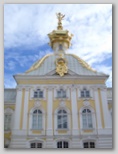
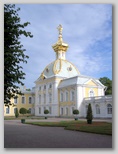


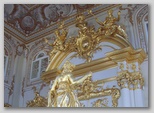
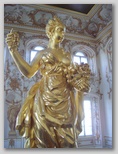
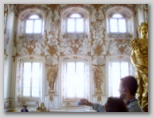
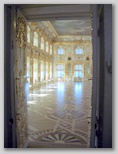
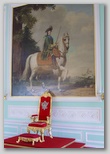

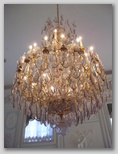
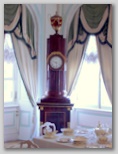
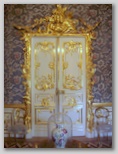
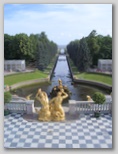
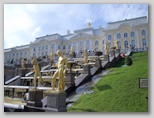
After Peterhof, we drove back into the city where we visited
a church across the water from the Hermitage protected within the walls of a
fort called the fortress of Peter and Paul. It is in this church that the
remains of most members of the royal family are entombed from Peter the Great
on. This was a private church of the royals and common people entered only when
viewing a deceased czar lying in state.
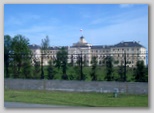 After
seeing decrepit structures throughout St.
Petersburg, we now had an opportunity to witness Peter
the Great’s vision through the grand palaces and buildings along the river and
canals of this section of town. The Muscovites, of whom most of the early
Communists were, hated St. Petersburg
for all the bourgeoisie trappings it contained. Maybe so, but bourgeois is more
pleasing to the eye.
After
seeing decrepit structures throughout St.
Petersburg, we now had an opportunity to witness Peter
the Great’s vision through the grand palaces and buildings along the river and
canals of this section of town. The Muscovites, of whom most of the early
Communists were, hated St. Petersburg
for all the bourgeoisie trappings it contained. Maybe so, but bourgeois is more
pleasing to the eye.
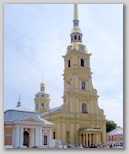
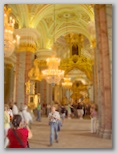
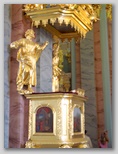

We had lunch at a restaurant called The Last Palace, so
called since the structure was considered to be the last of many palaces built
in the city. A harpist played in a grand ballroom as we dined on very good
Russian fare. That is saying quite a lot when the words “very good” and
“Russian fare” seldom appear in the same sentence. One reason for this is that St. Petersburg food is
heavily influenced by the French. Of course the obligatory shot of vodka helps.
I did learn that drinking it as the Russians do helps. One quick throw back and
down the hatch. It goes down very smoothly.
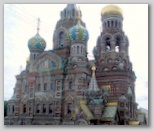 Two
more churches to take in. The first was formally named the Church of the
Resurrection and commonly know as the Church of the Spilled Blood. The later
name due to the fact that Alexander II was murdered there. A monument marks the
spot. It seems that murder was the common form of removing a head of state in
those days. Other czars suffered the same fate. In Alexander’s case, it was
thought that his reforms, such as freeing the serfs, were the cause. Apparently,
such things rankled the royals of the day.
Two
more churches to take in. The first was formally named the Church of the
Resurrection and commonly know as the Church of the Spilled Blood. The later
name due to the fact that Alexander II was murdered there. A monument marks the
spot. It seems that murder was the common form of removing a head of state in
those days. Other czars suffered the same fate. In Alexander’s case, it was
thought that his reforms, such as freeing the serfs, were the cause. Apparently,
such things rankled the royals of the day.
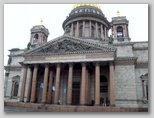 The
second church was one built in the early 1800s for the
The
second church was one built in the early 1800s for the 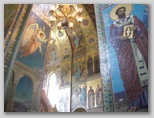 singular
purpose of baptizing royal children. The exterior looks like a Baptist church
built by a congregation with a wildly successful building campaign. The
interior is an attempt to copy the Vatican. Again, the common people
could not enter. I think it was here that I really understood the underlying
breeding of discontent in the masses as well as the particular disdain by the
Bolseviks for religion. The countries that continue to have their monarchs such
as Great Britain and the Netherlands
have royals that live well, but not heads and shoulders above the common
people.
singular
purpose of baptizing royal children. The exterior looks like a Baptist church
built by a congregation with a wildly successful building campaign. The
interior is an attempt to copy the Vatican. Again, the common people
could not enter. I think it was here that I really understood the underlying
breeding of discontent in the masses as well as the particular disdain by the
Bolseviks for religion. The countries that continue to have their monarchs such
as Great Britain and the Netherlands
have royals that live well, but not heads and shoulders above the common
people. 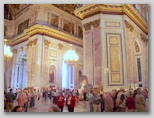 Windsor castle is a rambling old fort compared to the
likes of Versailles
or these Czarist excesses.
Windsor castle is a rambling old fort compared to the
likes of Versailles
or these Czarist excesses.

 After
seeing decrepit structures throughout
After
seeing decrepit structures throughout  Two
more churches to take in. The first was formally named the Church of the
Resurrection and commonly know as the Church of the Spilled Blood. The later
name due to the fact that Alexander II was murdered there. A monument marks the
spot. It seems that murder was the common form of removing a head of state in
those days. Other czars suffered the same fate. In Alexander’s case, it was
thought that his reforms, such as freeing the serfs, were the cause. Apparently,
such things rankled the royals of the day.
Two
more churches to take in. The first was formally named the Church of the
Resurrection and commonly know as the Church of the Spilled Blood. The later
name due to the fact that Alexander II was murdered there. A monument marks the
spot. It seems that murder was the common form of removing a head of state in
those days. Other czars suffered the same fate. In Alexander’s case, it was
thought that his reforms, such as freeing the serfs, were the cause. Apparently,
such things rankled the royals of the day. The
second church was one built in the early 1800s for the
The
second church was one built in the early 1800s for the  singular
purpose of baptizing royal children. The exterior looks like a Baptist church
built by a congregation with a wildly successful building campaign. The
interior is an attempt to copy the
singular
purpose of baptizing royal children. The exterior looks like a Baptist church
built by a congregation with a wildly successful building campaign. The
interior is an attempt to copy the 




















